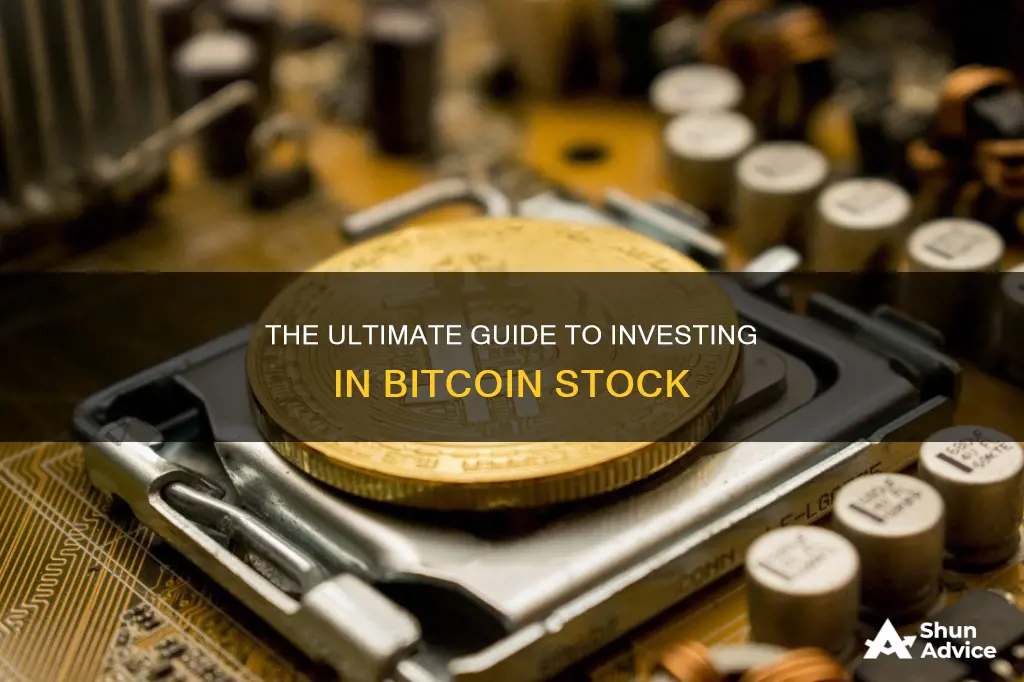
Bitcoin has become increasingly popular among investors in recent years, with its valuation increasing by more than 763% in a single year. This has been driven by several high-profile individuals and businesses, such as Elon Musk, accepting Bitcoin as a form of payment.
However, Bitcoin is a very high-risk investment due to its volatility. Its value may rise or fall dramatically over a short period, and it has no intrinsic value as it is not backed by any physical asset or central regulator.
If you want to invest in Bitcoin, you will need to join a Bitcoin exchange, get a Bitcoin wallet, connect your wallet to a bank account, place your Bitcoin order, and then manage your Bitcoin investments.
There are several popular Bitcoin exchanges, including Coinbase, Binance, Kraken, Gemini, and Bitfinex. You can also use apps such as Etoro, Axi, or IQ Option to trade Bitcoin stock.
| Characteristics | Values |
|---|---|
| How to buy Bitcoin | Via a crypto exchange or stockbroker, or a money transfer app such as PayPal, Venmo or Cash App |
| Bitcoin wallets | Hot wallets are online; cold wallets are offline; cold wallets are considered more secure |
| Risks | Bitcoin is a very high-risk and volatile investment |
| Other cryptocurrencies | Ethereum, Cardano, XRP, Solana, Dogecoin |
| Other ways to invest in Bitcoin | Bitcoin mining; investing in a company that uses Bitcoin technology; investing in a Bitcoin ETF |
What You'll Learn

Choosing a Bitcoin exchange
There are over 200 cryptocurrency exchanges on the market, so choosing the right one for you can be daunting. Here are some factors to consider when making your decision:
- Geographical location and restrictions: The majority of cryptocurrency exchanges have a limited geographical scope. Check that the exchange is accessible and legal in your country. For example, Binance is open to all countries except those on economic and trade sanctions lists.
- Volume and liquidity: A large trading volume is a good indicator of a crypto exchange's liquidity and ability to fill orders. If you're looking to trade one of the core pairs (BTC or ETH), a major centralized exchange will offer high liquidity. For smaller coins, you'll need to look at smaller or decentralized exchanges.
- Security, anonymity, and support: With billions lost to hacks and scams, security should be a top priority when choosing an exchange. While decentralized exchanges emphasize security and anonymity, centralized exchanges support higher volume and liquidity. Look for exchanges that offer two-factor authentication and know-your-customer (KYC) verification.
- Supported assets: If you want to buy cryptocurrencies beyond Bitcoin, check the number and range of supported assets. Some exchanges only support a handful of cryptocurrencies, while others allow you to trade hundreds.
- Payment methods: Most exchanges support wire transfers, but some also allow you to buy crypto with credit or debit cards.
- Fees: Research the fees charged by different exchanges, including trading fees and withdrawal fees. These can eat into your investment returns.
- Customer service: If you're new to crypto or investing, you may need help and will benefit from an exchange with good customer support.
- Reputation: Research the exchange's reputation by reading customer reviews, checking its history, and looking for recent news stories. For example, Coinbase has been charged by the SEC for allegedly operating as an unregistered securities exchange.
Some of the top-rated exchanges include Kraken, Coinbase, Crypto.com, Gemini, and BitMart.
The Future of Bitcoin: Predicting Your Investment's Worth
You may want to see also

Getting a Bitcoin wallet
To get a Bitcoin wallet, you'll need to decide what type of wallet you want. The most popular types are hosted wallets, non-custodial wallets, and hardware wallets.
Hosted Wallets
Hosted wallets are the most popular and easy-to-set-up type of crypto wallet. When you buy crypto using an app like Coinbase, your crypto is automatically held in a hosted wallet. This is because a third party, like a bank, keeps your crypto for you. The main benefit of a hosted wallet is that if you forget your password, you won't lose your crypto. However, a drawback is that you can't access everything crypto has to offer.
Non-Custodial Wallets
A self-custody wallet, like Coinbase Wallet, puts you in complete control of your crypto. Non-custodial wallets don't rely on a third party to keep your crypto safe. While they provide the software necessary to store your crypto, the responsibility of remembering and safeguarding your password falls entirely on you. If you lose or forget your password, there’s no way to access your crypto.
Hardware Wallets
A hardware wallet is a physical device, about the size of a thumb drive, that stores the private keys to your crypto offline. Most people don’t use hardware wallets because of their increased complexity and cost, but they do have some benefits. For example, they can keep your crypto secure even if your computer is hacked. However, this advanced security makes them inconvenient to use compared to a software wallet, and they can cost upwards of $100 to buy.
Once you've decided on the type of wallet you want, you can download a wallet app, create your account, and transfer your crypto to your wallet.
ID Coin Stock: A Guide to Investing in Digital Identity
You may want to see also

Connecting your wallet to a bank account
Connecting your crypto wallet to a bank account is a straightforward process, but it requires attention to detail. Here is a step-by-step guide:
Step 1: Choose a Reliable Platform
First, choose a reputable cryptocurrency platform that supports SEPA/SWIFT transfers and has strong security features and user reviews. Research the platform's fees to ensure you are getting a good deal.
Step 2: Register and Verify Your Account
If you don't already have an account on the chosen exchange, register and complete the necessary verification steps, including providing identification documents. This usually involves completing a KYC (Know Your Customer) check.
Step 3: Transfer Cryptos to the Exchange
Once you've signed up and been verified, you can buy or add Bitcoin to your account. You can use a credit/debit card to buy crypto or use your exchange's deposit address to initiate a transfer from your personal Bitcoin wallet.
Step 4: Sell or Trade Your Crypto
After the purchase or deposit is confirmed, select the Sell or Trade function on the platform. With the Trade function, look for the trading pair that corresponds to Bitcoin and your desired fiat currency (e.g. Bitcoin/USD or Bitcoin/EUR). Then place a sell order, making sure you are selling the correct amount of crypto.
Step 5: Withdraw Your Fiat Money
With the Sell function, you can sell your crypto directly to your bank account. Once the sell order is executed, the platform will convert your Bitcoin into the chosen fiat currency and send it to your bank account. Double-check the transaction details and the amount you are receiving.
Step 6: Add Your Bank Details
Enter your bank account details, including the IBAN number for SEPA transfers or the SWIFT/BIC code for SWIFT transfers. Always verify the accuracy of the information before proceeding.
Step 7: Monitor Your Bank Account
The platform will then process your withdrawal request. Depending on the platform and the type of transfer, the processing time can vary from immediate to a few days. Monitor your bank account periodically to ensure the transfer has gone through.
Alternative Methods
While the above method is the most common way to connect your crypto wallet to your bank account, there are alternative options. One way is to use a P2P (peer-to-peer) marketplace, which facilitates direct transactions between buyers and sellers. However, this method comes with certain risks, including the potential for fraud and payment delays, so thorough research is necessary.
Another alternative is to use a crypto debit card, which allows you to spend your crypto easily without transferring or moving your assets. These cards operate like traditional debit cards but allow you to spend your Bitcoin and other cryptocurrencies directly. They also allow cash withdrawals from ATMs.
Trump-Kim Commemorative Coin: Worthy Investment or Waste?
You may want to see also

Placing your first Bitcoin order
After choosing a crypto exchange, you will need to fund your account before beginning to invest in Bitcoin. Check if your exchange has a Bitcoin wallet built into its platform. If not, you’ll need to find one of your own. Once your account is funded and you have a wallet, you can place your first order to buy Bitcoin.
Depending on the platform you’re using, you may be able to purchase Bitcoin by tapping a button, or you may have to enter Bitcoin’s ticker symbol: BTC. Next, input the amount you want to invest. If Bitcoin’s current price is around $40,000, you’d need to invest that much to buy 1 BTC. If you invested less, say $1,000 when 1 BTC equals $40,000, you’d get a percentage of a Bitcoin equal to about 0.025 BTC.
There are several main types of trading orders that you can use when placing your first Bitcoin order:
- Market order: This is the simplest and most basic type of crypto order. It is an instruction by a trader to buy or sell a cryptocurrency at the best available price in the crypto market and provides instant execution. Crypto market orders are perfect for traders who do not wish to wait for a target price and, unlike all other orders, are guaranteed to be fulfilled. However, slippage is a significant drawback of market orders. This occurs when large market orders usually match multiple orders in the order book and may be susceptible to unfavorable changes in price.
- Limit order: This type of order allows you to purchase or sell Bitcoin at a predetermined price or better. Limit orders may ensure a more favourable fill price on average compared to market orders, but there is no guarantee that they will be completely filled or filled at all.
- Stop order: This type of order is set to buy or sell a cryptocurrency at the market price once a certain price has been hit. This order type helps traders protect profits and limit losses.
- Stop-limit order: This is an advanced order type that combines a stop order and a limit order. It is used to minimize risk and secure profits or curb losses. A stop-limit order will buy or sell the cryptocurrency once the stop price is reached, and the trading activity will continue until the whole order is filled.
Coinbase: A Guide to Investing in the Company
You may want to see also

Managing your Bitcoin investments
- Choose a reputable platform: When deciding where to buy and sell Bitcoin, select a well-known and regulated platform such as Coinbase, Crypto.com, or a traditional stockbroker. Avoid smaller or newer platforms that may pose security or liquidity risks.
- Weigh storage options: You'll need a crypto wallet to store your Bitcoin. Choose between a hot wallet, which is online and provided by crypto exchanges or software providers, and a cold wallet, an offline encrypted device. Hot wallets are more susceptible to hacking, so opt for an insured and well-regulated provider.
- Diversify your portfolio: Consider limiting your Bitcoin investment to a small portion of your overall portfolio, typically under 5%. Diversification can help balance the risks and rewards of investing in volatile assets like Bitcoin.
- Long-term strategy: While some investors choose to day-trade Bitcoin, a long-term strategy may be more rewarding for patient investors. Remember that Bitcoin investments are subject to capital gains taxes, so consult with a financial advisor to understand the tax implications.
- Manage risk: Bitcoin is a highly volatile asset, and its value can fluctuate widely. Only invest what you can afford to lose, and avoid taking on debt to invest in Bitcoin. Regularly assess your risk tolerance and adjust your investment strategy as needed.
- Stay informed: Keep yourself updated on the latest news, trends, and developments in the cryptocurrency market. Understand the factors that influence Bitcoin's value and be prepared for potential price swings.
- Security and privacy: Prioritize the security and privacy of your Bitcoin investments. Use strong passwords, two-factor authentication, and browse safely when accessing your crypto exchange account or digital wallet.
- Regular rebalancing: Periodically review and rebalance your portfolio to maintain a risk-reward profile that aligns with your investment goals and risk tolerance. Diversifying across multiple cryptocurrencies or other asset classes can also help manage risk.
Bitcoin's Early Investors: Unimaginable Wealth and Opportunities
You may want to see also
Frequently asked questions
To buy Bitcoin stock, you need to sign up for a reliable exchange, verify your identity, and fund your account. From there, you can set your own market limit orders to buy Bitcoin.
A Bitcoin Stock Exchange is a trading platform where people can access real-time prices to freely buy, sell or exchange Bitcoin with other virtual currencies or traditional fiat currencies.
For beginners and advanced traders, Etoro is the most popular and best overall trading platform for buying Bitcoin stock in large volumes with high liquidity.
Etoro is supported worldwide and is a popular Bitcoin trading platform for day traders.







